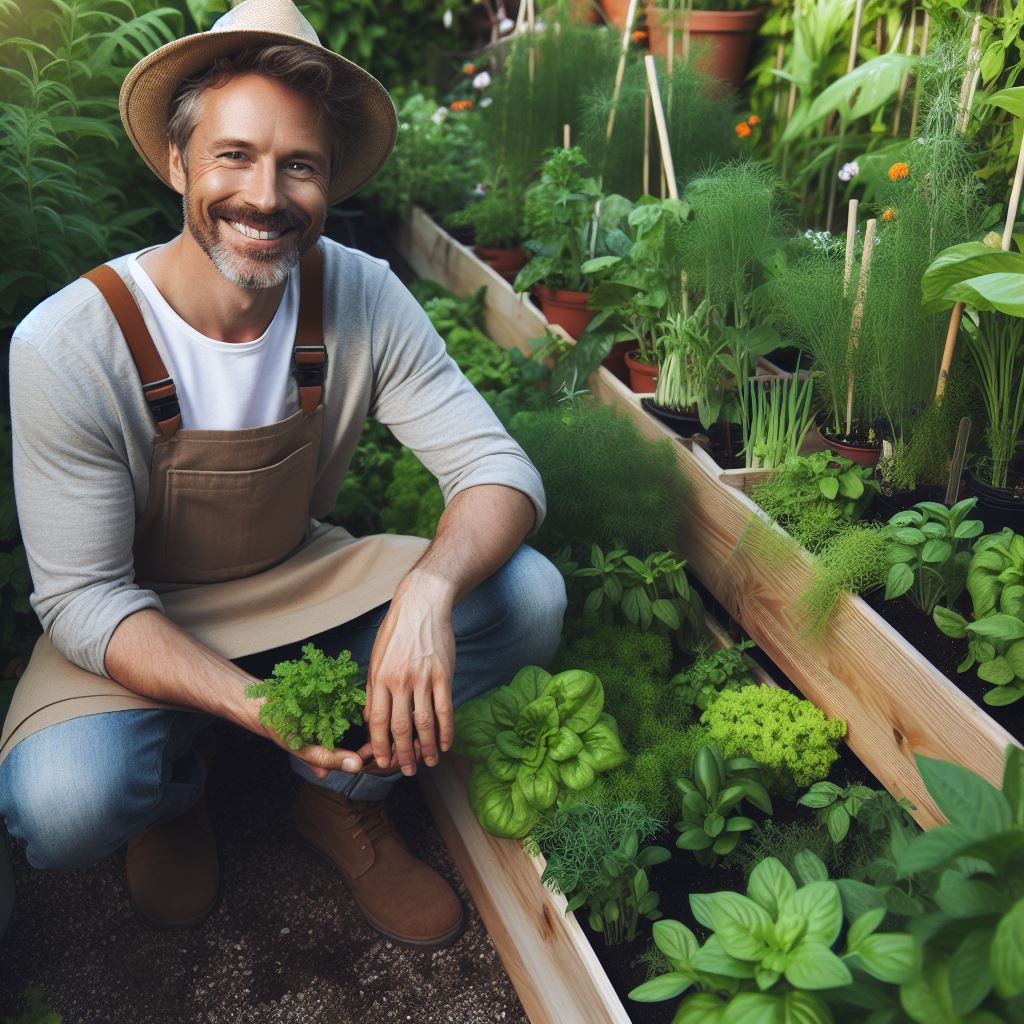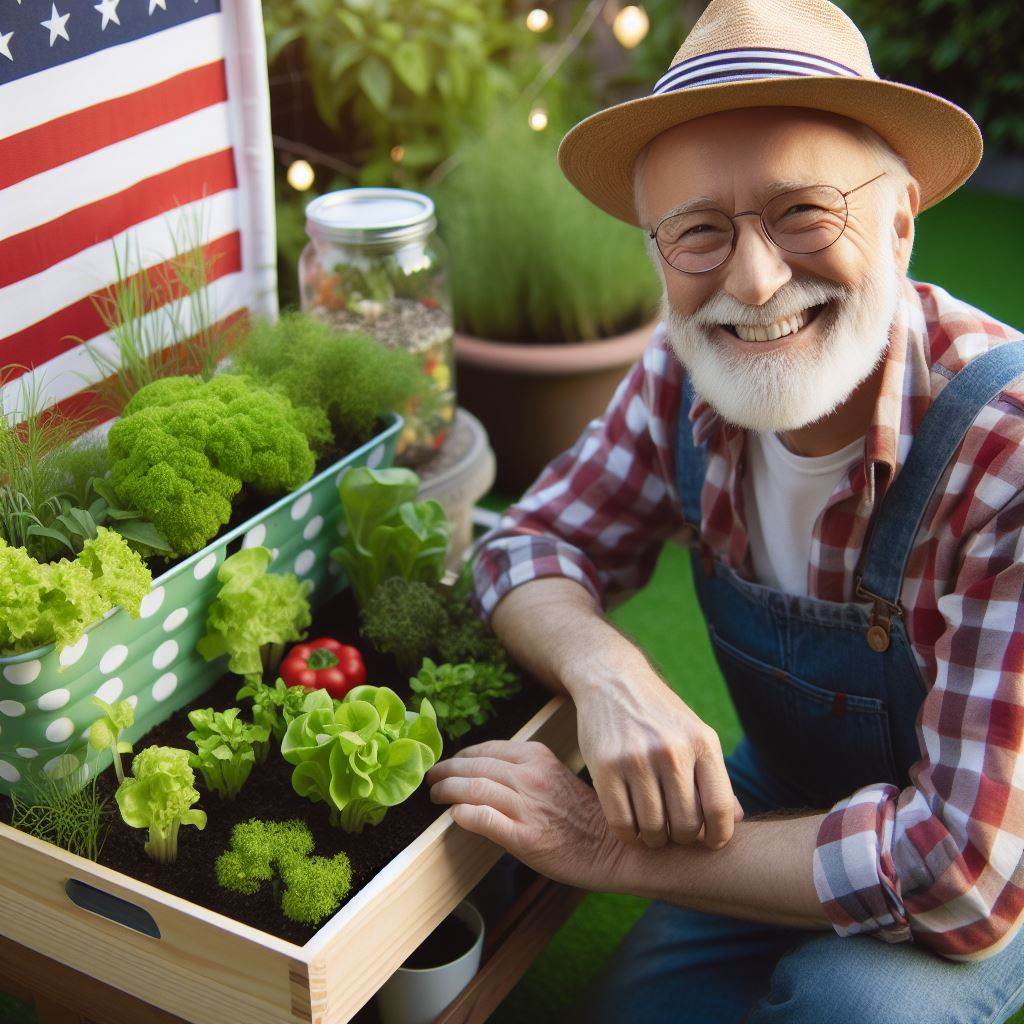Introduction
Having a small organic garden can be a rewarding experience, but it also requires careful planning and implementation to ensure maximum yield.
By optimizing the space available and using effective cultivation techniques, you can greatly increase the productivity of your garden.
Importance of maximizing yield in small organic gardens
Maximizing yield in small organic gardens is essential for several reasons.
First and foremost, it allows you to make the most of limited space, ensuring that every inch of your garden is utilized efficiently.
This is particularly important if you have a small yard or if you live in an urban area with limited space for gardening.
Furthermore, maximizing yield in small organic gardens promotes sustainable food production.
With the increasing need for organic and locally sourced food, it is crucial to produce as much food as possible in smaller spaces, minimizing the need for transportation and reducing the carbon footprint associated with conventional farming.
Overview of the blog post topic
In this blog post, we will delve into various techniques and strategies to maximize yield in small organic gardens.
We will discuss the importance of selecting the right crops for limited space, using companion planting to optimize plant growth and pest control, implementing vertical gardening techniques, utilizing proper soil management, and other innovative methods.
By the end of this blog post, you will have a comprehensive understanding of how to make the most of your small organic garden and achieve high yields.
Whether you are a beginner or an experienced gardener, these tips and techniques will help you optimize your gardening efforts and increase your harvest.
Proper planning and preparation
Assessing available space in the garden
In order to maximize yield in small organic gardens, it is crucial to assess the available space. Here are some important factors to consider:
- Sunlight: Determine which areas of the garden receive the most sunlight throughout the day. This will help you decide where to position your plants.
- Soil quality: Test the soil to understand its composition and fertility. This will help you choose plants that are suitable for the specific soil conditions in your garden.
- Microclimates: Identify any microclimates in your garden, such as areas that are hotter or cooler than the surrounding environment. This will enable you to make more informed decisions regarding plant placement.
- Vertical space: Utilize vertical space by growing plants on trellises, fences, or stakes, allowing you to maximize the use of limited ground area.
Researching suitable organic gardening methods
Choosing the right gardening methods is key for success in small organic gardens.
Here are some effective techniques:
- Companion planting: Research plants that provide natural pest control or enhance each other’s growth when planted together.
- Intensive planting: Utilize square foot gardening or intercropping techniques to make the most of limited space.
- Vertical gardening: Explore vertical gardening methods such as using hanging baskets, vertical planters, or utilizing walls and fences.
- Container gardening: Consider growing plants in containers such as pots, raised beds, or window boxes, allowing for flexibility and easy movement.
- Crop rotation: Implement a crop rotation plan to prevent soil nutrient depletion and reduce the risk of pests and diseases.
Choosing the right plants for small spaces
Selecting the appropriate plants is essential for maximizing yield in small organic gardens.
Transform Your Agribusiness
Unlock your farm's potential with expert advice tailored to your needs. Get actionable steps that drive real results.
Get StartedConsider the following:
- Dwarf varieties: Opt for compact or dwarf varieties of vegetables, fruits, and herbs that are specifically bred for small spaces.
- Heritage or heirloom plants: Choose heritage or heirloom plant varieties that are known to have a high yield and adaptability to different growing conditions.
- Succession planting: Plant crops that mature at different times to maximize the use of space and ensure a continuous harvest throughout the growing season.
- Edible flowers and herbs: Incorporate edible flowers and herbs that not only provide additional yield but also attract beneficial insects to your garden.
By assessing the available space, researching suitable gardening methods, and choosing the right plants, small organic gardens can yield bountiful harvests while making the most of limited space.
Read: Space-Saving Farm: Hydroponic Techniques
Optimizing soil health
Testing and improving soil quality
To maximize yield in small organic gardens, it is crucial to optimize soil health.
One of the first steps in achieving this is testing and improving soil quality.
By understanding the composition of the soil, gardeners can make informed decisions about soil improvement strategies.
Soil testing is essential to determine the nutrient levels and pH balance of the soil.
This information helps gardeners identify any deficiencies or imbalances that may hinder plant growth.
Soil tests can be carried out using DIY kits or by sending samples to a laboratory.
Based on the results of soil tests, gardeners can then take steps to improve soil quality.
One effective technique is the addition of organic matter.
Organic matter, such as compost or aged manure, can enhance soil structure, increase nutrient availability, and improve water retention.
Another method to enhance soil quality is through cover cropping.
Cover crops, such as legumes or grasses, are sown in fall or early spring and later tilled into the soil.
This practice helps reduce erosion, suppresses weeds, and adds organic matter to the soil.
Proper soil amendment techniques
In addition to adding organic matter, proper soil amendment techniques are crucial for maximizing yield in small organic gardens.
One technique is called double-digging, which involves loosening the soil to allow plant roots to penetrate deeply.
Double-digging entails removing the top layer of soil and loosening the subsoil to a depth of two spade lengths.
This process improves aeration, drainage, and root penetration. It is important to avoid compacting the soil after double-digging, as this can negate its benefits.
Gardeners should also practice crop rotation to prevent the depletion of specific nutrients in the soil.
By rotating the types of plants grown in different areas each year, nutrient imbalances are minimized, and overall soil health is maintained.
Using compost and organic fertilizers
Using compost and organic fertilizers is another vital aspect of maximizing yield in small organic gardens.
Compost is an excellent source of organic matter and helps replenish nutrients in the soil.
It also promotes beneficial soil organisms and improves soil structure.
Showcase Your Farming Business
Publish your professional farming services profile on our blog for a one-time fee of $200 and reach a dedicated audience of farmers and agribusiness owners.
Publish Your ProfileTo produce quality compost, gardeners should aim for a balanced mix of green (nitrogen-rich) and brown (carbon-rich) materials.
Common green materials include vegetable scraps, grass clippings, and coffee grounds.
Brown materials include dried leaves, straw, and shredded newspaper.
Organic fertilizers, such as bone meal, blood meal, or fish emulsion, can help supplement nutrient requirements in the garden.
These natural fertilizers release nutrients slowly, providing a steady supply of nourishment to the plants.
It is important to apply compost and organic fertilizers at the appropriate times during the growing season.
Adding compost in spring and fall, and fertilizers when plants require a boost, ensures optimal nutrient availability for healthy plant growth.
In short, maximizing yield in small organic gardens requires a focus on optimizing soil health.
By testing and improving soil quality, utilizing proper soil amendment techniques, and using compost and organic fertilizers, gardeners can create an environment where plants thrive.
Investing time and effort in soil optimization will result in healthier plants, higher yields, and a more sustainable and productive organic garden.
Read: Urban Oasis: Aquaponic Gardening Basics
Efficient space utilization
Companion planting techniques
One of the ways to maximize yield in small organic gardens is by using companion planting techniques.
This involves planting different types of plants together that benefit each other.
Companion plants can aid in pest control, improve soil fertility, and enhance pollination.
For example, planting marigolds alongside vegetables can repel pests like aphids and nematodes.
Additionally, certain plants have a symbiotic relationship where one provides nutrients for the other.
For instance, legumes like beans and peas can fix nitrogen in the soil, benefiting neighboring plants with their natural fertilizer.
Companion planting can also help with space utilization.
By selecting plants of different heights and growth habits, you can maximize vertical space.
For example, tall plants like corn can provide shade for shorter plants like lettuce.
Vertical gardening strategies
Another effective way to optimize space in small organic gardens is by implementing vertical gardening strategies.
Vertical gardening involves growing plants upwards instead of spreading them horizontally.
Using trellises, stakes, or fences, you can train plants like tomatoes, cucumbers, and beans to grow vertically.
This not only saves space but also enables better air circulation, reduces disease susceptibility, and makes harvesting easier.
Additionally, vertical gardening can be integrated with companion planting techniques.
For instance, climbing plants can be planted alongside taller plants, creating a vertical garden with a diverse array of crops.
Intercropping and succession planting
Intercropping and succession planting are two more techniques to maximize yield in limited space.
Intercropping involves growing different crops together in the same area simultaneously.
By combining plants with different growth rates and nutrient requirements, you can maximize space utilization and optimize resources.
For example, fast-growing crops like lettuce can be grown between slower-growing plants like tomatoes.
Succession planting is the practice of planting new crops as soon as one is harvested.
This ensures a continuous supply of fresh produce throughout the growing season.
For instance, once you harvest radishes, you can immediately sow seeds for another crop like carrots or beets in the same space.
This way, you can make the most of your garden’s limited area and extend the harvest period.
Essentially, maximizing yield in small organic gardens requires efficient space utilization.
Companion planting techniques can promote plant health and optimize space usage.
Vertical gardening strategies save space and enhance plant growth.
Intercropping and succession planting ensure a continuous harvest.
By implementing these techniques, small organic gardens can produce abundant and diverse crops.
Read: From Water to Table: Hydroponic Growing
Showcase Your Farming Business
Publish your professional farming services profile on our blog for a one-time fee of $200 and reach a dedicated audience of farmers and agribusiness owners.
Publish Your ProfileWater Management
Installing Drip Irrigation Systems
In small organic gardens, maximizing yield is crucial, and one effective way to achieve this is by installing drip irrigation systems.
Drip irrigation provides water directly to the plant’s roots, reducing water waste and ensuring optimal hydration.
Drip irrigation systems consist of hoses or tubes with small holes that allow water to slowly drip onto the soil near the plants.
This method prevents water from evaporating in the air or running off the surface, leading to better water efficiency.
By installing a drip irrigation system, gardeners can control the amount of water plants receive, avoiding overwatering or underwatering.
This precision allows plants to grow at their best, resulting in healthier yields.
Watering Techniques for Optimal Plant Growth
In addition to drip irrigation systems, mastering proper watering techniques is essential for maximizing yield in small organic gardens.
Here are some tips to ensure optimal plant growth:
- Water in the morning or evening: Avoid watering plants during the hottest part of the day when evaporation rates are high. Watering early in the morning or late in the evening helps plants absorb moisture effectively.
- Water at the base of plants: Direct the water flow to the base of the plants, not on the leaves. This ensures the water reaches the plant’s roots, providing maximum hydration.
- Water deeply but infrequently: Instead of shallow, daily watering, give plants a deep soak once or twice a week. This encourages the development of deep, strong root systems.
- Use mulch: Applying a layer of organic mulch around plants helps retain moisture in the soil, reducing the need for frequent watering.
- Monitor soil moisture: Regularly check the soil moisture levels by sticking your finger an inch or two into the soil. If it feels dry at that depth, it’s time to water.
By employing these watering techniques, gardeners can promote optimal plant growth, leading to higher yields in small organic gardens.
Collecting and Preserving Rainwater
Another water management strategy for small organic gardens is collecting and preserving rainwater.
Rainwater is pure, natural, and lacks the chemicals and additives found in tap water.
Collecting rainwater can be as simple as placing containers or barrels under downspouts, allowing them to fill during rain events.
This harvested rainwater can then be used to water plants during dry spells, reducing the reliance on other water sources.
Avoiding runoff from roofs and paved areas can help to collect even more rainwater.
Redirecting gutters towards the garden or using permeable paving can enhance rainwater collection.
To preserve rainwater, cover storage containers to prevent evaporation and keep them clean to avoid contamination.
Using screens or filters can also prevent debris from clogging irrigation systems.
Rainwater is naturally soft and free from disinfectants, making it an excellent choice for delicate plants.
It can also help maintain a healthy soil structure, preserving the natural balance of microorganisms.
By collecting and preserving rainwater, small organic gardens can minimize their ecological impact and achieve maximum yield, all while utilizing a sustainable water source.
Read: Organic Garden Pest Identification Guide

Weed and pest control
Manual weed removal methods
Weeds can drastically reduce the yield in small organic gardens, so it’s important to control them effectively.
- Hand-pulling: One of the simplest and most effective ways to control weeds is to manually pull them out by hand.
- Digging: For tougher weeds with deep roots, use a small hand tool like a trowel to dig them out completely.
- Hoeing: Use a hoe to cut weeds off at the soil line, making sure to sever their roots for effective control.
- Mulching: A layer of organic mulch, such as straw or wood chips, can smother weeds and prevent them from germinating.
Natural pest management options
In addition to weeds, pests can also damage plants and reduce yield in small organic gardens. Here are some natural ways to manage pests:
- Biological control: Introduce beneficial insects like ladybugs or praying mantises that feed on garden pests.
- DIY sprays: Homemade sprays made from ingredients like garlic, neem oil, or hot pepper can repel pests.
- Barriers: Physical barriers like row covers or netting can prevent pests from reaching the plants.
- Crop rotation: Rotate crops annually to disrupt the life cycle of pests and reduce their populations.
Companion planting for pest deterrent
Companion planting involves planting certain crops together to benefit each other.
Here are some examples:
- Marigolds: Plant marigolds around vegetables to deter pests like aphids, nematodes, and whiteflies.
- Nasturtiums: These flowers attract aphids, which helps keep them away from other plants in the garden.
- Basil: Planting basil near tomatoes can repel mosquitoes, flies, and tomato hornworms.
- Mint: Mint can repel pests like ants, aphids, and cabbage moths, making it a great companion for various crops.
Companion planting is a natural and effective way to deter pests without relying on chemical solutions.
Taking a proactive approach to weed and pest control is crucial for maximizing yield in small organic gardens.
By implementing manual weed removal methods, exploring natural pest management options, and incorporating companion planting techniques, gardeners can ensure a bountiful harvest without compromising organic principles.
Regular maintenance and care
Pruning and trimming techniques
Proper pruning and trimming are essential tasks to maximize yield in small organic gardens.
By removing dead or diseased branches, you prevent the spread of diseases and pests, ensuring healthier plants.
- Start by inspecting your plants regularly – this will help you identify any dead, damaged, or diseased branches.
- Use sharp and clean pruning shears to make clean cuts. Avoid tearing or ripping the branches as this can lead to infection.
- Remove any branches that are crossing or rubbing against each other. This will prevent them from competing for nutrients and sunlight.
- Trim back any excessive growth, especially on vigorous plants, to maintain an airy and open structure. This allows better air circulation and sunlight penetration.
Proper mulching and monitoring plant health
Mulching is another important practice that aids in maximizing yield and maintaining plant health.
The layer of organic materials spread around the base of plants helps retain moisture, suppresses weeds, and improves soil fertility.
- Choose organic mulching materials such as straw, wood chips, or compost. These materials slowly break down, providing nutrients to the soil.
- Apply a layer of mulch around the base of plants, ensuring it does not touch the stems. This prevents rotting and potential pest infestation.
- Monitor the health of your plants regularly. Keep an eye out for signs of nutrient deficiencies, pests, or diseases.
- Address any issues promptly to prevent them from spreading to other plants in your garden. Organic pest control methods and foliar sprays can be effective in maintaining plant health.
Regular harvesting to encourage continuous yield
Regular harvesting is crucial to maximize the yield in small organic gardens.
By harvesting crops promptly, you stimulate further growth and encourage a continuous supply of fresh produce.
- Harvest crops at their peak ripeness. This ensures the best flavor and nutritional value.
- Pick fruits and vegetables in the morning when they are cool and have high moisture content.
- Use sharp and clean garden scissors or pruning shears to avoid damaging the plants during harvesting.
- Remove any damaged or overripe produce to prevent them from attracting pests and diseases.
- Continue harvesting regularly, even if you have an abundant supply. This promotes new growth and extends the productive life of your plants.
In general, regular maintenance and care are fundamental in maximizing yield in small organic gardens.
Proper pruning and trimming, along with adequate mulching and monitoring plant health, ensure healthier and more productive plants.
Additionally, regular harvesting encourages continuous growth and prolongs the productivity of your garden.
By following these practices, you can enjoy bountiful harvests from your small organic garden.
Importance of crop rotation
In small organic gardens, crop rotation plays a vital role in maximizing yield and maintaining a healthy ecosystem.
By strategically changing the location of crops over time, gardeners can prevent soil nutrient depletion, avoid disease and pest buildup, and ultimately maximize overall garden productivity.
Showcase Your Farming Business
Publish your professional farming services profile on our blog for a one-time fee of $200 and reach a dedicated audience of farmers and agribusiness owners.
Publish Your ProfilePreventing soil nutrient depletion
One of the key benefits of crop rotation is its ability to prevent soil nutrient depletion.
Different plant families have different nutrient requirements; rotating crops helps ensure that one nutrient isn’t constantly being depleted from the soil.
For example, legumes, like beans and peas, can fix nitrogen from the air, enriching the soil for future plantings.
By rotating legumes with other crops, gardeners can maintain the nitrogen levels in the soil, promoting healthy growth and high yields.
Similarly, rotating crops with deep root systems, such as carrots or beets, helps break up compacted soil and improves drainage, preventing nutrient buildup and promoting overall soil health.
Avoiding disease and pest buildup
Crop rotation also plays a crucial role in minimizing disease and pest buildup in small organic gardens.
Certain plant diseases and pests have specific hosts, and by rotating crops, gardeners can break the lifecycle of these pests and diseases.
For example, if a specific crop is susceptible to a particular disease, rotating it with a non-host crop can help break the disease cycle, reducing the risk of infection in subsequent plantings.
Additionally, by avoiding planting the same crop in the same location year after year, gardeners can reduce pest populations that may have become established in the area due to the consistent presence of their preferred host plant.
Maximizing overall garden productivity
Finally, crop rotation is instrumental in maximizing overall garden productivity.
By preventing soil nutrient depletion and minimizing disease and pest buildup, gardeners can ensure that their plants have the necessary resources to grow and flourish.
Furthermore, rotating crops helps improve soil structure and fertility over time.
Each crop brings different benefits to the soil, such as increased organic matter or improved water retention.
By diversifying plantings and implementing a crop rotation plan, gardeners can create a balanced and self-sustaining ecosystem that supports abundant growth and high yields.
In essence, crop rotation is a fundamental practice that should be implemented in small organic gardens to maximize yield.
By preventing soil nutrient depletion, avoiding disease and pest buildup, and maximizing overall garden productivity, gardeners can create thriving and productive organic gardens year after year.
Monitoring and Record Keeping
A successful small organic garden requires careful monitoring and record keeping to maximize yield and ensure future success.
By tracking plant growth and yield progression, identifying patterns, and adapting strategies, gardeners can make informed decisions for optimal results.
Moreover, using records for future garden planning helps maintain productivity and overcome challenges.
Here are some valuable insights on monitoring and record keeping in small organic gardens:
Tracking Plant Growth and Yield Progression
One of the essential aspects of maximizing yield in a small organic garden is to closely monitor and track plant growth and the progression of yields.
Regular observations help identify potential issues or areas that need improvement.
Check on plant health, size, and overall development frequently to catch any signs of nutrient deficiency, pests, or diseases.
Keep a record of the growth rates and yield amounts to compare with previous seasons and make necessary adjustments.
Measure the height, width, and diameter of plants regularly to track their growth progress accurately.
Note down the number and weight of harvested produce.
Maintaining a growth and yield log allows for the easy identification of trends and helps assess if the garden is meeting targets.
Identifying Patterns and Adapting Strategies
Recording observations in a systematic manner enables gardeners to identify patterns in plant growth, yield progression, and overall garden performance.
By taking note of which plants thrive in specific conditions, it becomes easier to adapt strategies for improved yield and garden productivity.
For example, if a certain variety consistently yields higher or encounters fewer pest issues, consider giving it more space in the garden or expanding its planting in subsequent seasons.
Additionally, by recording the timing of pests or disease outbreaks, gardeners can proactively plan preventive measures, such as companion planting or introducing beneficial insects.
Monitor environmental factors such as sunlight exposure, soil moisture, and temperature fluctuations to analyze their impact on plant growth and yield.
With this data, gardeners can manipulate variables like watering schedules or shade cover to optimize conditions and maximize yield.
Using Records for Future Garden Planning
Record keeping in small organic gardens serves as a valuable resource for future garden planning.
By maintaining a detailed log, gardeners can refer to previous seasons’ records to make informed decisions and avoid repeating past mistakes.
Reviewing yield records helps in determining which plant varieties provide the most satisfactory results.
Additionally, using records to analyze crop rotation patterns ensures optimal soil fertility and reduces the likelihood of diseases and pests that can build up in the soil over time.
Furthermore, records aid in efficient space usage.
By referring to previous planting layouts and yield records, gardeners can plan crop spacing and succession planting effectively, maximizing the garden’s productivity and ensuring a continuous harvest throughout the growing season.
Finally, record keeping helps identify trends and improvements over time, allowing gardeners to celebrate successes and seek ways to enhance overall garden performance.
Showcase Your Farming Business
Publish your professional farming services profile on our blog for a one-time fee of $200 and reach a dedicated audience of farmers and agribusiness owners.
Publish Your ProfileIt encourages experimentation and fosters a continuous learning process, which is crucial for the long-term success of small organic gardens.
In a nutshell, monitoring and record keeping are essential practices for maximizing yield in small organic gardens.
By closely tracking plant growth and yield progression, identifying patterns, and adapting strategies, gardeners can make informed decisions to optimize their garden’s productivity.
Using records for future garden planning ensures efficient space usage and assists in crop rotation and variety selection.
Embracing these practices not only leads to better yields but also enhances the overall gardening experience.
Conclusion
In order to maximize yield in small organic gardens, it is important to plan properly, utilize companion planting, practice crop rotation, manage pests, and maintain healthy soil.
Even though small organic gardens may present challenges, they can still be incredibly productive and rewarding.
Each garden is unique, so it’s crucial to try different methods and adjust as necessary to find what works best.
Small organic gardeners play a vital role in promoting sustainable and healthy food production.
Join the movement and continue to grow your garden!




